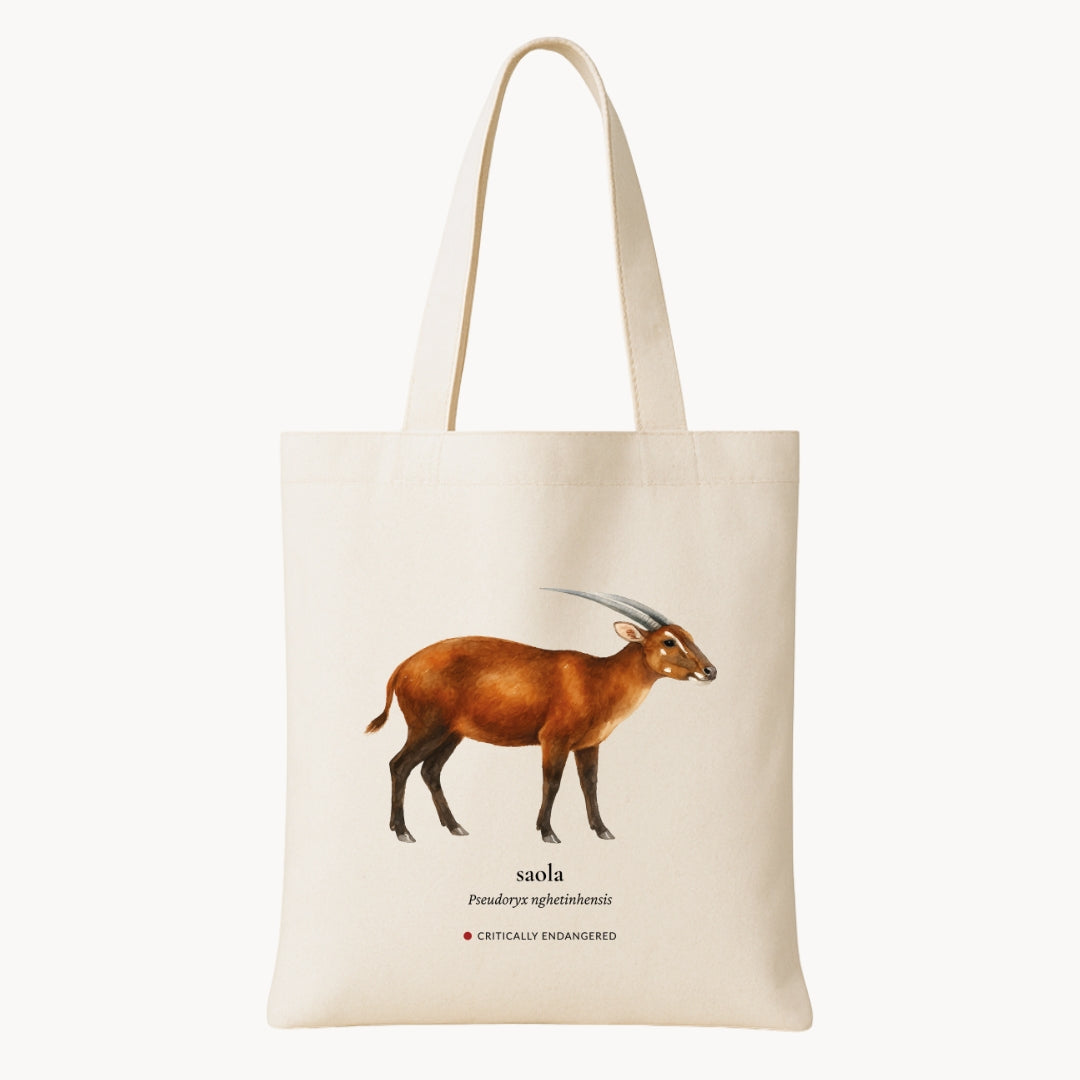
Carry the trace of a mystery almost lost to time.
This tote features the elusive saola — rarely seen, rarely photographed — illustrated in soft watercolor and printed on ethically sourced fabric. A symbol of wilderness that still resists the reach of modern life.
The saola (Pseudoryx nghetinhensis) is one of the world’s rarest large mammals, discovered by science only in 1992. Native to the Annamite Mountains along the Laos–Vietnam border, it’s often called the “Asian unicorn” for its rarity and graceful horns.
With no saola known to survive in captivity and fewer than a few hundred believed to exist in the wild, it faces extinction due to snare hunting, habitat fragmentation, and human encroachment.
Part of The Vanishing Wild collection, this tote quietly honors a creature few will ever see — but whose existence still stirs the imagination.
Specifications
Material: 80% GOTS-certified organic cotton, 20% GRS-certified recycled polyester
Bag Dimensions: 14.6" × 15.4" (37 × 39 cm)
Handle Length: 25.6" (65 cm)
Thoughtfully Constructed:
• Double-folded top edge for clean finish and strength
• Shaping seams on sides for added storage space
• Reinforced double-stitched handles for extra durability
• Soft, strong fabric created from specially processed cotton fibers and high-resilience recycled polyester
What You’ll Love
- Elegant watercolor illustration of a critically endangered whale
- Includes common name, scientific name, and conservation status
- Soft neutral tone suits any style or season
- Made with certified sustainable materials
- Perfect as a gift with meaning or a personal pledge for the planet
- Exclusive part of The Vanishing Wild series
Usage Guidance
- Use daily — from farmer’s market to field notes
- Start conversations around conservation and biodiversity
- Gift to eco-conscious friends, marine biology lovers, or animal advocates
- A beautiful companion to your zero-waste lifestyle
Care Instruction
- Machine wash separately: Cold (max 30°C / 90°F) on gentle cycle
- Do not bleach — use mild, natural detergent
- Air dry only — do not tumble dry
- Iron, steam, or dry: Low heat only
- Do not dry clean
How Your Purchase Helps the Environment
- Made using GOTS-certified organic cotton and GRS-certified recycled polyester
- Produced by Stanley/Stella, a certified ethical manufacturer committed to sustainable sourcing
- Reduces demand for single-use plastic bags
- Raises awareness of the world’s most threatened species
- A portion of profits supports reforestation and global conservation through our partnered programs
Eco-Friendly Shipping
Our shipping takes approximately 2 to 4 weeks as we prioritize consolidated shipping methods. By grouping orders together, we significantly reduce the number of individual shipments. This approach helps lower our carbon footprint and supports a more sustainable and environmentally friendly shipping process.
Frequently Asked Questions
Q: What makes this tote bag sustainable?
A: Each bag is crafted using GOTS-certified organic cotton and GRS-certified recycled polyester, then ethically produced by Stanley/Stella — a leader in sustainable fashion. It's designed to reduce waste and promote long-term reuse.
Q: Where is the tote bag shipped from?
A: All tote bags are shipped from Poland through our trusted production partner. This helps ensure efficient delivery within Europe and reduces the carbon footprint of global shipping.
Q: Is this product vegan?
A: Yes! This tote is PETA-Approved Vegan, meaning no animal-derived materials are used at any stage of production.
Q: What does "The Vanishing Wild" series mean?
A: The Vanishing Wild is our exclusive collection highlighting animals with declining or endangered populations. Each design features their common name, scientific name, and IUCN conservation status, paired with original watercolor artwork.
Q: Will the tote bag hold heavy items?
A: Yes — it’s built to last. The bag features reinforced stitching, shaping seams for extra room, and a double-folded top edge for added strength. It's ideal for books, groceries, or everyday use.
Q: How should I care for this bag?
A: • Machine wash separately in cold water (max 30°C / 90°F) on gentle cycle
• Do not bleach or use harsh chemicals
• Air dry only — do not tumble dry
• Iron on low heat if needed
• Do not dry clean
Q: Why is the saola critically endangered?
A: The saola (Pseudoryx nghetinhensis) is listed as Critically Endangered and is one of the rarest and most elusive mammals on Earth. The main threats to its survival include:
• Widespread snare hunting, where wire traps set for other animals unintentionally capture and kill saola
• Habitat loss, as forests in the Annamite Mountains are cleared for agriculture, infrastructure, and logging
• Fragmentation of its range, which isolates small populations and reduces breeding opportunities
• No known individuals in captivity, meaning there’s no safety net if wild populations disappear
Since its scientific discovery in 1992, sightings have been vanishingly rare. Without urgent action, the saola could quietly disappear without most of the world ever seeing one.





